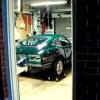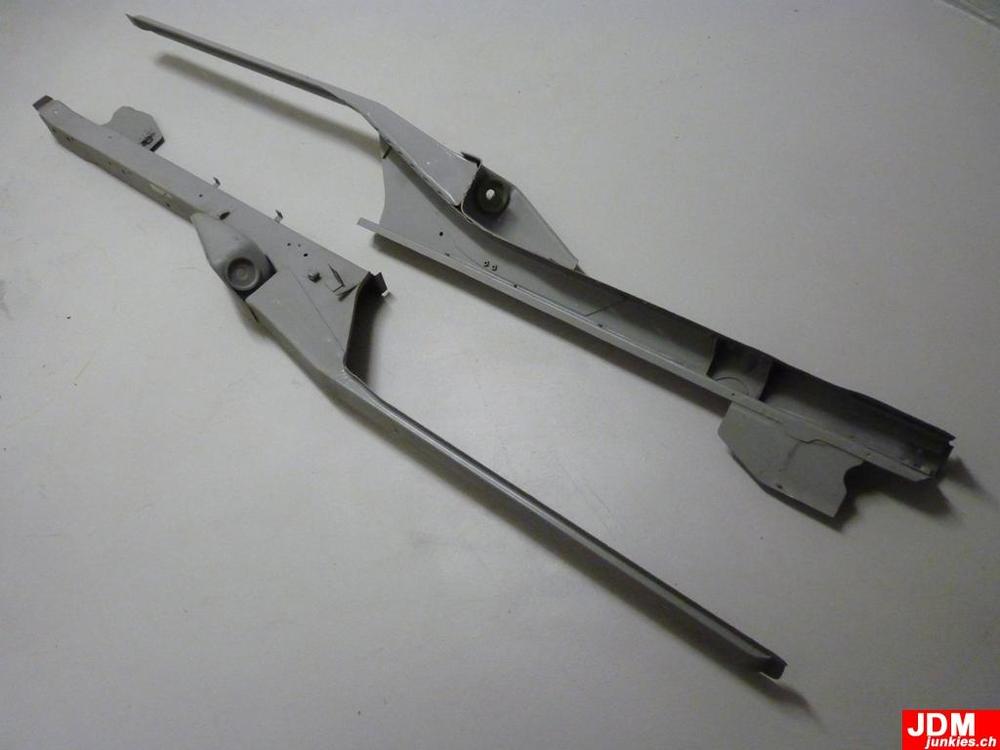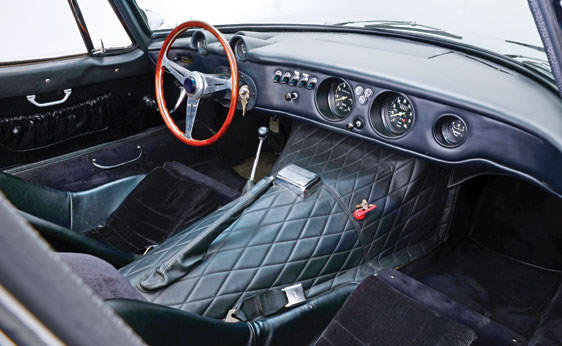Everything posted by Namerow
-
Safety announcement: Check your steering mechanism’s safety, especially if a little sloppy.
I also used the same U-joint successfully. IIRC, I might have needed to grind down the shoulders of the spider casting a bit to get the clearance required to make them fit. The bigger issue for me was removing the original spiders. I ended up having to cut through one of the spider's legs using my Dremel and a cutting disc. If you find that you need to do this, you'll be extra-careful not to damage the yoke while you're cutting through the spider.
-
Sway bar / frame rail repair
only photo i could find. these are OE rails. if you stare really hard you'll get a sense of what the reinforcement looked like when new.
-
Antenna cable length
Looks like the OE cable is metric @ 4m length (which converts to 13 ft 1.5 in)
-
Seats: what's considered restored vs redone?
I will add 2 cents more here, based on my experiences with repainting my interior trim... The SEM prep products work very well. Read and follow the manufacturer's instructions before you start. Comparatively speaking, successful results are easy to achieve for the hard-plastic panels but not-so-easy to achieve with the soft-vinyl trim. The challenge for achieving good results with the soft-vinyl trim lies in the 'quilting' pattern that's molded into the material. It creates traps for the silicones contained in 'conditioning' products like ArmorAll (very popular in the 1970's and 1980's). Those silicones act as a repellent for the water-based vinyl paint and result in a paint-coverage defect called 'fish-eye' (you won't like it, trust me). It is really difficult to get 100% of the silicones off of the Z's quilted vinyl trim. For reference, the cleanliness test for these panels is to apply water from a hose and watch to see whether the water 'sheets' as it drains off the panel. If there's any evidence of 'beading', then the panel's not clean. Unfortunately, this test lies is less than bullet-proof when used on the quilted vinyl pieces because, while the water may be sheeting off the big surfaces between the quilting lines, it is not sheeting off the surfaces along the quilting lines. It was my experience that I needed to triple the number of cleaning repetitions recommended by SEM before I got a decent result with the paint application on the quilted vinyl. I was very happy with my end result, but it took a lot of scrubbing. You do not want to use the paint application step as your check for whether your panels are clean enough. If you get a paint defect and need to re-apply, the defective paint coating is a b**ch to remove once it sets up. Unfortunately, adding additional layers of paint to try to cover the defective area doesn't really work very well. The moral is this: With the quilted soft-vinyl trim pieces, you need to purposely over-clean. You cannot risk under-cleaning.
-
Seats: what's considered restored vs redone?
'Restored' means whatever you want it to mean. It all depends on what's important to you. The factors that typically come into play: 'original' vs. 'improved' vs. 'custom' (one person's idea of 'improved' is another person's idea of 'ruined') color match (make the new seats match the faded trim? Or replace the faded trim to match the new seats?) cost (see Item 2) appearance (see 'original' vs ''improved' vs 'custom' manufacturer's warranty ergo comfort (the OE seat design is 'just ok' in this regard. Some people replace them with Miata seats for this reason.) other comfort issues (leather is nicer than vinyl if you live in a hot-sun region) quality of fit (some replacement covers fit better than others -- although a good upholstery shop can probably overcome this) smell (most prefer leather over vinyl... while others consider the Z' interior's scent-of-vinyl to be part of its charm) durability (I haven't heard any bad reports about the leather covers, but they are stitched and that can sometimes lead to problems. As most of us know, the outboard upper seat bolster in these cars take a beating. The lower seat cushion is a high-load area, too.) It will probably help you most to get advice from our members on what not to buy (and why). From that point, it's pretty much up to you and whatever you think will make you happy.
-
1976 280Z Restoration Project
I really respect the effort that goes into parts restorations like this. Lots of effort. Lots of ingenuity. It's a completely different ethos than the 'buy new' community. Great result and you educated me about a new wonder-chemical: Dominion's 'SureTex Flexible Texture Material'. p.s. I'll bet our American members don't get the 'Dominion' part
-
options for transmission hump covering
Ever wonder where Nissan took its inspiration from when it decided to go with the quilted-vinyl look for the Z's interior panels? A good bet would be the 1965 Bizzarini 5300 GT -- one of the premiere supercars of its day. I wouldn't be at all surprised if Bizzarini's trimmer had already been using this material for speedboats. It's not a look that appeals to everyone.
- 240z - fabbing new front rails
- 240z - fabbing new front rails
-
Sunvisor refresh
When an upholstery fitter uses steam, it's done as an aid while physically working the piece to achieve the desired positioning. And that's what takes the wrinkles out. To put it another way, you may have to strategically stretch the vinyl while it's soft so as to try to get a more uniform stretch across the full surface. This might be risky work, because your visors now each have a long, taped seam. Based on your 'before' photos, it looks like you were already 90% of the way to a perfect job. Maybe not worth stressing over the last 10%, esp. when: a) nobody but you will notice the difference, and; b) you risk making a mistake and ruining the nice result you've got right now.
-
Relationship solution
Ironic, too, that Haynes is a British publisher. Brings to mind an old saying: "If Britannia rules the waves, then why can't the British build a car that can drive through a puddle without stalling?" Mind you, it appears that the Brits were looking at practical implementations of electricity as early as the 1600`s -- long before the likes of Ben Franklin, Count Volta, Galvani, Volta and Ampere appeared on the scene. In fact, they apparently invented the words, 'electric' and 'electricity'.
-
COVID-19
Shifting topics for a moment, here's a useful op-ed piece in today's Toronto Globe & Mail about the two-way value of masks. The writer is, "a retired public health specialist and epidemiologist... [with] more than 30 years of experience, including 23 with the Public Health Agency of Canada, where he actively participated in previous outbreaks of SARS, H5N1, H1N1 and H7N9." "Masks protect the wearer, too - and lower our risk for contracting COVID-19" I, for one, have been surprised the dialog that's emerged over the past few weeks to the effect that masks have value only for protecting others. I ask myself, 'When I'm wearing a mask while I'm sandblasting or spray-painting, am I really doing that because I'm trying to protect someone else?'
-
Sunvisor refresh
Thanks. I think I get it now. Results look good. I like your resourcefulness. I wonder if a little heat would help the vinyl to relax and let the wrinkles/waves settle out a bit? If you decide to try this, the upholsterer's secret is to use steam rather than hot air. A heat gun will probably destroy the visor and even a hair dryer can cause harm to thin vinyl if you're not careful. Hand-held steamers only cost $25 or so.
-
Sunvisor refresh
Very nice work. A few questions for you on 'technique': Why did you decide it was necessary to glue the new foam in place? It looks like it would have stayed in place w/o the need for glue. Did you really manage to bring the two seams together perfectly, first time, or did it take a few tries to get it right? If so, how did that work out? That Gorilla tape sounds pretty unforgiving. The picture where you're just bringing the top and bottom edges together makes me wonder how you managed to push the tape back into visor cavity without getting it wrinkled and/or making a mess (which you clearly didn't). How was this accomplished? What is this 'scalpel' thing that you used? Hobby knife, or actual medical scalpel? Overall, I'm concerned that the tape joint is going to give up over time, esp. right at the seam and esp. when exposed to summer heat. I guess only time will tell.
- Help Identifying a Radio
-
What's the most needed Z part that's currently NLA?
What about the top insulators for the suspension struts? Have these become NLA? FWIW, I've often wondered just how much these insulators affect ride quality and cabin (road) noise levels and whether 50 years of aging affects the resilience of the rubber core to the point where they're worth replacing. I know that lesser parts on the car made of rubber tend to become rock-hard with age and there's always lots of chatter about the latest idea for a chemical treatment to soften them up. Another thing that nags at me is whether new-old-stock rubber parts of this type suffer from the same aging effects simply by sitting on the shelf for the same period of time as the ones that have been out on the road. I guess the only way to gauge the importance of the strut insulators would be by doing back-to-back measurements on the same vehicle and road after swapping out the old insulators for a set of 'new' ones. That's probably never going to happen within our small community of Datsun Z owners, but I wonder whether anyone has ever done this kind of comparison test with some other vehicle?
-
What's the most needed Z part that's currently NLA?
Yes, of course. They say that memory is the second thing to go I'll update the table. And a repro of the lid (less hardware) is now being offered by Steve at www.240zrubberparts.com It's the ashtray that remains NLA. Complicated shape to reproduce. A mold would be difficult. 3D printing may be the only route.
-
What's the most needed Z part that's currently NLA?
Mike at Banzai Motorworks (Marlboro, MD) has offered fully-trimmed door cards for many years (1970 - 73 models). Website shows them currently priced at $305/pair and available in black, red, white or butterscotch. Includes the molded-in chrome trim strip. Mike's products are usually highly faithful to the originals, so I expect that these will be accurate and high-quality. www.zzxdatsun.com/catSoftTrim.php Charlie Osborne at Zedd Findings (Kingston, ON, Canada) has,, likewise, offered fully-trimmed door cards for many years, although his products are restricted to the 280ZX niche market. http://www.datsunzparts.com/doorpanels.html There may very well be other vendors who offer similar products, or products for different model years.
-
COVID-19
Can't help but thinking about what happened to the doctor in China who called his government out over its failure to confront reality.
-
What's the most needed Z part that's currently NLA?
Summary of what we've heard so far... Part Category Suggested by Suggester’s Comments Diff Front Mount (insulator) – ‘early’ type (PN 55415 E4102) Drivetrain Namerow No convenient workarounds that preserve originality of ‘early’ driveline layout. Hatch Glass Glass S30Driver Getting difficult to find in acceptable to pristine condition. Side Window Glass Glass S30Driver Getting difficult to find in acceptable to pristine condition. Carpet underlay pieces, cut-to-shape from OE-spec jute material Floor Coverings Gav240z Correct material not readily available and not pre-cut Sound deadener pieces (cabin side of firewall) Floor Coverings Gav240z Correct material not readily available and not pre-cut Carpets in correct, loop-style Floor Coverings Gav240z Carpets in correct material not readily available Rear quarter panels Body Panels Gav240z Closest available is Tabco’s partial patch panel Roof panel Body Panels Gav240z Required to fix cars cut for sunroof. Re-pop panel not available. Rear valence panel (aka rear ‘apron’ / ‘roll’ panel) Body Panels Gav240z Available re-pops fit OK but are not accurate in certain details. Ashtray – ‘early’ type Interior Gav240z ‘fragile’ Center console – ‘early’ type Interior Mike Fuse box cover plate – ‘early’ type Interior Mike ‘Nismo’ fuel pump mounting bracket Body Parts Mike Not an OE part, but…
-
vinyl paint interior...?
Parasol Paints in Toronto, Canada (www.parasolinc.com) will custom-mix a vinyl paint to perfectly match your color. Send them a small sample of vinyl from the underside of a seat or cut from the back hem of a trim panel. A 1/2-inch square will do. You'll need 1 qt. to do the dash and centre console (estimated cost of US$100/qt, shipping extra). I had them mix up two quarts the match my butterscotch seats (sourced from Banzai). The color match was spot on, the product applied very nicely, and it has held up very well over the years (no lifting or peeling). Parasol's vinyl paint is applied with a standard-issue HVLP spray gun. It's water-based and the gun cleans up easily, provided that you do this right after you finish spraying). You'll need to apply at least 3 medium coats to cover a black surface with a light brown paint. Regardless of whose vinyl paint you end up using, you will need to be relentless in your prep work. All traces of silicone (ArmorAll, etc) need to be removed or else you will get major 'fish-eye' when you try to apply the paint (and you can't just wipe the crazed vinyl paint off and start over again). SEM offers a pair of cleaning products for a two-step process. Effective (if used properly), but not cheap. Parasol offers their own line of cleaners.
-
1970 HLS30-06521 Re-Restoration
My 70 Z is a US car originally from Colorado (VIN in the 003500's) and it has the plastic 'clamshell' wiper motor cover. It came to Canada late in its life, so unlikely that the motor and cover were replaced with a 'Canadian-market' item. I think that this design was replaced by the bag for a few reasons: easier installation into the cowl cavity during vehicle assembly better protection of the motor from rain/snow less expensive to produce
-
What's the most needed Z part that's currently NLA?
Thanks for spotting this. You're right. I've gone back and edited the captions for photos #2 and #3. The early-design mount is identified by the non-rectangular shape of its outer plate. Sorry for the mix-up.
-
What's the most needed Z part that's currently NLA?
If that's an early-style diff mount and still in as-new condition, it's worth $$$ . But if it's, "correct for my car 2-72", then it's the new style mount and can be safely left laying around in your garage.
-
S30 Sheet Metal - Body and Chassis Panel Thicknesses
Is that a roof panel I see on one of those racks? If it is, and if you don't mind the climb, it would be interesting to get a thickness measurement off that piece. I can't see it being less than 0.8mm, but it would be nice to know for sure. Hard to get this measurement off an intact car, unless it's been cut for a sunroof. Not urgent, but maybe when you better access develops.








